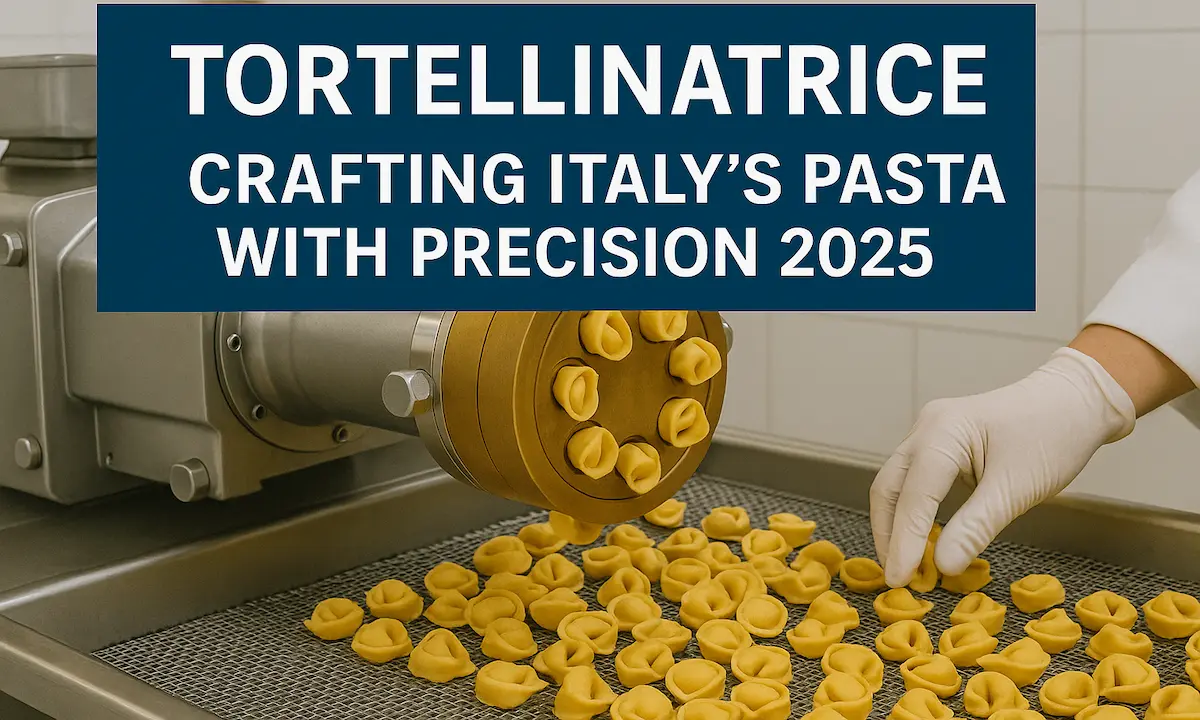In the heart of Italy’s culinary legacy lies a small, delicate pasta that has captured hearts and stomachs around the world—tortellini.
With their signature ring shape and flavorful fillings, tortellini are more than food; they’re symbols of family, region, and artisan heritage.
But how does this intricate delicacy transition from generations of skilled hands to global supermarket shelves?
The answer is a remarkable machine known as the tortellinatrice—a technological marvel designed to replicate centuries-old pasta-making techniques at modern scale.
Quietly working behind the scenes in pasta labs and factory lines, this machine combines mechanical precision with culinary tradition to produce thousands of tortellini every hour—each one nearly identical in shape, structure, and seal.
In this article, we’ll explore the origins, mechanics, evolution, and cultural significance of the tortellinatrice, as well as the future innovations shaping this unsung hero of Italian gastronomy.
Lets dive in!
What Is a Tortellinatrice?
The tortellinatrice is a highly specialized pasta machine created specifically for the production of tortellini.
Unlike standard pasta rollers or cutters, the tortellinatrice performs a sophisticated series of operations: rolling dough sheets, injecting precise amounts of filling, folding the dough, and sealing it into the iconic navel-shaped ring.
Its name—“tortellinatrice”—comes from the Italian word “tortellini” combined with “-atrice,” denoting a feminine noun used for machines.
Its job is simple in concept but complex in execution: to mimic the artisanal touch of skilled pasta makers while maintaining efficiency, hygiene, and consistency.
Modern tortellinatrici are found in everything from large-scale factories to boutique pasta workshops. Whether you’re eating packaged tortellini in Chicago or fresh-filled pasta in Milan, there’s a good chance it was shaped by one of these machines.
From Bologna to the World: A Brief History
Tortellini originated in the Emilia-Romagna region of Italy, particularly in Bologna and Modena. Traditionally handmade during holidays and family gatherings, the pasta represents love, craftsmanship, and regional identity.
But as the global appetite for Italian cuisine grew, manual methods could no longer meet demand. The first tortellinatrice prototypes appeared in the 1960s and 70s—large, noisy, and limited in versatility. They were capable of mass production but lacked finesse.
Today’s models, thanks to advances in robotics, sensors, and food-safe materials, can replicate the delicate twists of human hands at industrial speeds. What was once a hand-rolled symbol of love is now an accessible staple for millions—all without losing its soul.
Inside the Machine: How a Tortellinatrice Works
At first glance, a tortellinatrice may look like a boxy piece of stainless-steel machinery, but under the hood lies a series of carefully coordinated systems. Let’s break down how it operates:
| Phase | Function |
|---|---|
| 1. Dough Feeding | Dough is kneaded and flattened into thin sheets using automated rollers. |
| 2. Filling Injection | Nozzles insert precise portions of filling onto the dough at regular intervals. |
| 3. Folding & Twisting | Pneumatic arms fold the dough into crescent shapes, then twist the ends to form the signature ring. |
| 4. Sealing | Pressure ensures each tortellino is tightly closed to prevent leakage during cooking. |
| 5. Cutting & Output | Excess dough is trimmed, and perfect tortellini are ejected onto trays or conveyor belts. |
This choreography of motion, pressure, and timing makes the tortellinatrice stand out from generic pasta machines. It’s not just producing food—it’s reproducing tradition.
Tortellinatrice vs. Other Pasta Machines
Not all pasta machines are created equal. While many machines can extrude or cut pasta shapes, the tortellinatrice performs a far more intricate task.
Here’s how it compares to other common pasta machines:
| Machine Type | Function | Best For |
|---|---|---|
| Pasta Extruder | Pushes dough through dies | Penne, spaghetti, fusilli |
| Ravioli Maker | Fills and seals pasta sheets in squares | Large, flat filled pasta |
| Tortellinatrice | Folds, twists, and seals in a ring shape | Authentic tortellini |
| Gnocchi Roller | Cuts and textures soft dough | Gnocchi, potato-based pasta |
The tortellinatrice is the only machine capable of replicating the curved “bellybutton” shape of tortellini—a process that requires subtle folds and an understanding of tension and sealing. This makes it essential for pasta makers who value culinary authenticity.
Tortellini: A Cultural Icon
Tortellini are more than just delicious—they’re a source of national pride.
In Bologna, Italy, there’s even a group called the Confraternita del Tortellino (Brotherhood of the Tortellino) that protects and promotes traditional preparation methods.
According to local legend, the shape of tortellini was inspired by the navel of the goddess Venus—a symbol of beauty, fertility, and love.
In this light, the tortellinatrice doesn’t dilute the tradition—it helps to preserve it in an age where mass production often comes at the cost of character.
Who Uses a Tortellinatrice?
You don’t need to be a giant food corporation to use a tortellinatrice. Today, these machines serve a wide range of culinary players:
- Industrial Food Brands: Large-scale models produce thousands of tortellini per hour.
- Artisan Pasta Labs: Small-batch machines deliver consistency with flexibility.
- Restaurants & Trattorias: Compact models support chefs in high-demand kitchens.
- Culinary Schools: Used as training tools to connect traditional knowledge with modern tools.
As demand for fresh, handmade-quality pasta grows, the tortellinatrice is becoming a mainstay in commercial and educational kitchens alike.
Customization, Modularity, and Smart Tech
Modern tortellinatrici are modular and programmable, allowing pasta makers to:
- Switch between different shapes and sizes
- Adjust dough thickness
- Change fillings (meat, cheese, plant-based)
- Use colored or flavored doughs (spinach, beetroot, squid ink)
High-end models now feature:
- Touchscreen Interfaces
- AI-assisted quality control
- Memory presets for recipe consistency
- Quick-cleaning modular parts
Some even integrate with factory-wide automation systems, allowing for real-time productivity tracking and food safety compliance.
Challenges and Considerations
While incredibly useful, the tortellinatrice comes with its own set of challenges:
| Factor | Challenge |
|---|---|
| Cost | High-end machines can cost $50,000+ |
| Training | Operators need to understand both mechanics and food safety |
| Maintenance | Regular cleaning and calibration are essential |
| Filling Quality | Poorly prepared filling can clog nozzles or break seals |
Despite these hurdles, the efficiency, precision, and scalability of the tortellinatrice make it a worthwhile investment for serious pasta producers.
Tortellini Around the World: Global Expansion
The rise of the tortellinatrice has transformed tortellini from a regional delicacy into a global favorite. Whether you’re in New York, Tokyo, or São Paulo, chances are you can find packaged tortellini at your local grocery store.
Here’s how the tortellinatrice helped fuel this expansion:
- Consistent Quality: Machine-formed tortellini ensures uniformity across batches.
- Scalability: High-output models allow producers to meet international demand.
- Cultural Flexibility: The tortellinatrice supports non-traditional fillings (e.g., spicy paneer, teriyaki chicken, vegan blends) to suit regional tastes.
By enabling global customization without compromising on quality, the tortellinatrice acts as a culinary bridge between Italy and the world.
Green Machines: Eco-Friendly Innovations
As sustainability becomes a priority, tortellinatrice manufacturers are responding with eco-conscious upgrades:
- Low-energy motors that reduce electricity usage by 30–40%
- Precision filling systems that cut down on ingredient waste
- Biodegradable internal components made from food-safe polymers
- Solar-powered prototypes designed for off-grid or mobile pasta units
Some machines even integrate directly into sustainable packaging lines, reducing human handling and minimizing contamination risk. It’s all part of aligning culinary heritage with climate responsibility.
Chefs + Machines = Culinary Creativity
While machines do the heavy lifting, the creative soul of pasta making still rests with chefs. In modern kitchens, the tortellinatrice works alongside humans—not in place of them.
Creative uses of the tortellinatrice include:
- Custom tortellini with seasonal or exotic fillings
- Playful pasta colors made with natural dyes (beet, squid ink, turmeric)
- Infusing dough with flavors like saffron or truffle
- Using unusual shapes and folding variations
Many chefs use the tortellinatrice to batch-produce the base, then add artisanal flair by hand, blending speed with storytelling.
The Future of Tortellinatrice Technology
Looking ahead, the tortellinatrice is poised to become smarter, smaller, and more powerful:
- Home Models: Compact machines for passionate home chefs
- AI Monitoring: For automatic adjustment of folding precision and dough elasticity
- Blockchain Integration: For ingredient traceability and transparency
- Augmented Reality Training: Interactive guides for setup and use
Just as espresso machines went from industrial use to home counters, the tortellinatrice could soon find a spot in everyday kitchens.
Conclusion: A Machine That Honors Tradition
The tortellinatrice is more than a mechanical tool. It represents a new chapter in Italian culinary heritage, where innovation doesn’t replace tradition—it reinforces and expands it.
From local trattorias to global supermarkets, tortellini made by these machines retain the shape, flavor, and symbolism that make them iconic. Whether folded by hand or guided through steel molds, tortellini remain an art form—delicate, delicious, and deeply meaningful.
The future of pasta isn’t about removing human touch. It’s about giving more people the tools to express it at scale. And at the heart of that effort is the tortellinatrice: Italy’s most elegant food machine.
FAQs
What is a tortellinatrice used for?
A tortellinatrice is a pasta machine designed to fold, fill, and seal tortellini automatically. It simulates hand-folding with precision, making it ideal for high-volume or artisanal production.
Can I use a tortellinatrice at home?
Yes. While most models are built for factories, compact versions are available for home chefs, small restaurants, or culinary schools. These offer the same core functionality with simpler controls.
How is a tortellinatrice different from a ravioli machine?
A ravioli machine seals pasta in squares or rectangles, while a tortellinatrice creates the curved, ring-shaped tortellini that mimics handmade preparation.
What fillings work best in a tortellinatrice?
Smooth, puréed fillings like ricotta, spinach, or finely ground meats work best. Chunky mixtures can cause clogging or poor seals.
Are tortellinatrici eco-friendly?
New models use low-energy motors, reduce filling waste, and are built with biodegradable or recyclable parts, making them increasingly sustainable.












